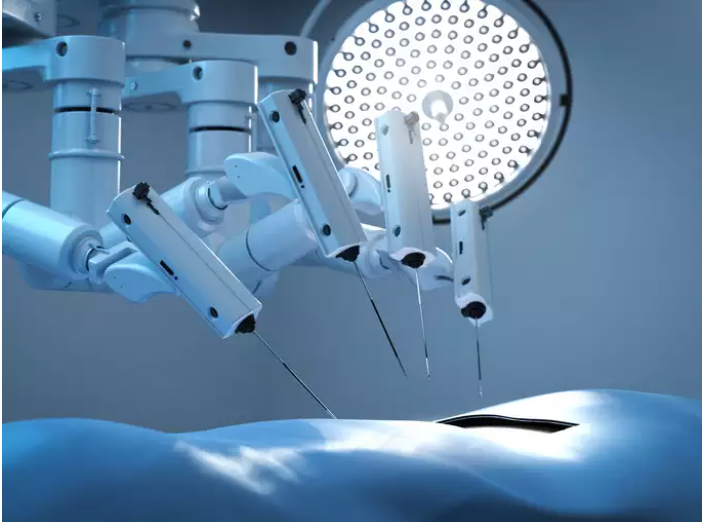
[ad_1]
 by Dr. Prashanth M Kulkarni
by Dr. Prashanth M Kulkarni
Robotic technology, has revolutionised surgical care in India during the last decade. The extensive use of robotic technology in urology and urologic oncology has fundamentally changed the way urologists approach illnesses and malignancy in less than a decade. The technology’s growth in urology has been aided by the short-term benefits of minimally invasive surgery with robotic assistance (e.g., less blood loss, improved convalescence, and ergonomic appeal). Identifying transferable surgical processes of care that are most important for each of the robotic cases in urologic oncology (e.g., prostatectomy, cystectomy, and partial nephrectomy) is a decisive step toward improving the quality of surgical care in urology and urologic cancer care, even if the long-term benefits of its use in urologic surgery are evolving.
Urology has always been at the forefront of innovation and research as a specialty. As a result, newer technologies were quickly embraced and, in many cases, improved to improve patient outcomes.
Robotic surgery revolutionised the surgical treatment of urological cancers, and most surgeons, especially urologists, would agree that the benefits much exceed the downsides. Surgeons may now work in very compact places with a greater range of motion thanks to robotics. Furthermore, robotic technology has enabled laparoscopic urologists to do minimally invasive surgery with greater ease and precision allowing for a broader and faster adoption among surgeons. As a result, hospitals with cutting-edge surgical technology and skilled surgical care teams that may give patients with possibly better outcomes tend to be preferred.
Robotic-assisted surgery using Intuitive’s surgical system has given surgeons new capabilities that can be applied to a variety of complicated and challenging urologic oncology operations. For example, during radical prostatectomy, robot-assisted procedures may make it easier for surgeons to operate in tight, constricted locations, such as the male pelvis. Furthermore, while doing a partial nephrectomy for kidney cancer, a surgeon may need to sacrifice a larger portion of a normal kidney when employing traditional methods such as laparoscopic surgery. For kidney malignancies less than 4 cm in diameter, partial nephrectomy has become the standard of therapy. However, there is still debate about the appropriate surgical approach, especially when minimally invasive procedures like laparoscopy and robotic-assisted surgery are considered. Both LPN (laparascopic partial nephrectomy) and RPN (robotic-assisted partial nephrectomy) have developed promising procedures that allow surgeons to provide the same level of care as open partial nephrectomy while using a less intrusive approach.
Robot-assisted surgery enables the surgeon to cut only the affected part of the organ, thus potentially preserving maximal function. Furthermore, advanced technologies such as the Firefly help identify tumor margicn more accurately. After kidney cancer removal, adequate residual kidney function is one of the most crucial factors in ensuring good quality of life postoperatively. This concept of nephron-sparing surgery is fundamental in diabetic, hypertensive and renal function compromised patients who are diagnosed with kidney cancer.
Robotic partial nephrectomy (RPN) is increasingly gaining prominence for nephron-sparing surgery in the treatment of patients with localised kidney tumours. Compared to open or laparoscopic surgery, RPN provides the benefits of minimally invasive surgery with a shorter learning curve. Furthermore, robotic surgery has facilitated technical innovation, including reducing warm ischemia time, provided minimally invasive alternatives to patients with complex tumours, and, more importantly, has fuelled increased dissemination of partial nephrectomy surgery among community urologists. This has the potential to reduce the need for dialysis in the long run and may help people to live longer and healthier lives. However, since the first planned partial nephrectomy completed in 1887, it took over a century to become recommended practice for small renal tumours and crucial in effectively managing small renal masses.
Robotic partial nephrectomy is both safe and feasible for select patients with complex renal tumours, including hilar, endophytic, and multiple tumours. In addition, robotic assistance may facilitate a minimally invasive, nephron-sparing approach for select patients with complex renal tumours who might otherwise require open surgery or total nephrectomy. It must also be noted that studies have shown that the pain score and the time taken to conduct the surgery is considerably lower in robotic-assisted surgery as compared to that of traditional surgery approaches such as the open or laparascopic method.
Performing a robotic partial and/or total nephrectomy using the da Vinci surgical system has shown significantly shorter operating times, blood loss, decreased margin positivity rate and hospital stays compared to traditional open access. Some highly specialised and trained roboticists can also offer retroperitoneal robotic access since the kidneys are located behind the abdominal cavity in the retroperitoneal space. This approach provides a safer, more direct route. In addition, open nephrectomies involving partial rib dissections are no longer required now that robotic and laparoscopic techniques are the standard method.
Robotic assistance in urology has become the standard approach for most urologic oncology treatments in recent years. This revolutionary approach, which has already altered the operating room, still has a lot of potential for expansion. The additional capabilities that the technology affords surgeons, as well as the exceptional clinical outcomes that result, will continue to have a lasting favourable impact on the therapy field, leading to a greater emphasis on training as awareness and adoption develop. Robotic surgery will potentially become the main method of all surgeries, influencing the future of healthcare in India.
Dr. Prashanth M Kulkarni, Consultant Urologist, Narayana Health, Bengaluru
(DISCLAIMER: The views expressed are solely of the author and ETHealthworld.com does not necessarily subscribe to it. ETHealthworld.com shall not be responsible for any damage caused to any person/organisation directly or indirectly.)
[ad_2]
Source link